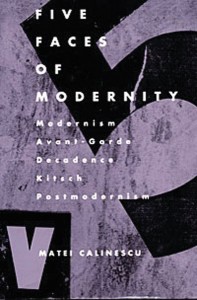 |
Matei Calinescu. Five Faces of Modernity: Modernism, Avant-Garde, Decadence, Kitsch, Postmodernism. Durham: Duke University Press, 1987.
Five Faces of Modernity tells five scholarly tales about how modernity developed in art and culture. Calinescu does not overlook the shady margins of cultural hierarchies, and so he escapes the vice that has been typical for nearly all “archeologists” of modernity (Andreas Huyssen being an exception.) The most fascinating chapter of Five Faces of Modernity is Calinescu’s in-depth analysis of the development of the concept of kitsch, its origin and the hierarchical stance possible only in the 1910s and 1920s, once the culture of art was already well developed—so well developed, in fact, that high culture, in order to continue expanding, needed an enemy. For me, the most important message of Calinescu’s book is that as artists worked to reach middlebrow culture, kitsch has governed much production of art. A must for anyone interested in the great divide between art and popular culture.
|